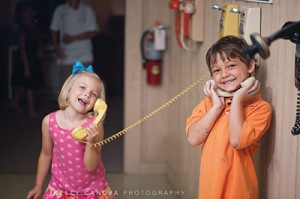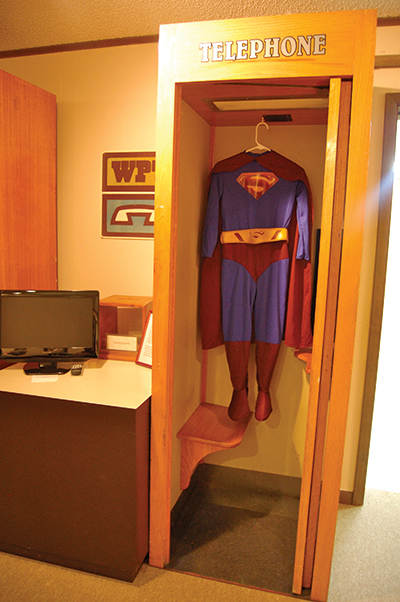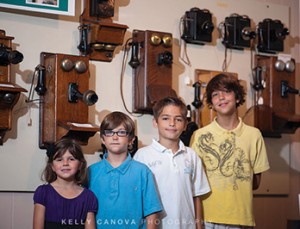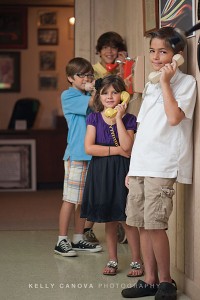Calling All Telephone Lovers And Superheroes
 Children are obsessed with telephones. They’ll turn any object ─ a large Lego brick, a banana, the dog’s toy, etc. ─ into a phone and conduct a pretend conversation with Grandpa or their favorite character. Online memes have been dedicated to the topic of imaginary play: a popular one shows a church’s billboard stating, “I don’t care how big and bad you are. When a toddler hands you a pretend phone, you answer it.”
Children are obsessed with telephones. They’ll turn any object ─ a large Lego brick, a banana, the dog’s toy, etc. ─ into a phone and conduct a pretend conversation with Grandpa or their favorite character. Online memes have been dedicated to the topic of imaginary play: a popular one shows a church’s billboard stating, “I don’t care how big and bad you are. When a toddler hands you a pretend phone, you answer it.”
The Telephone Museum at the Maitland Art Center makes the history of these communication devices fun and encourages hands-on exploration through most of the exhibits, with a playful nod to the super powers of the Clark Kent-Superman telephone booth, made famous from comic books and motion pictures!
“Kids are really fascinated by phones. Very small children see adults interacting on phones, but they don’t see who’s on the other side, so it’s like this magical technology,” said Andrea Bailey Cox, executive director of the Telephone Museum. “It’s the magic of the technology paired with the basic human need to communicate.”
 As part of the Maitland Art Center’s monthly Family Fun Day, the Telephone Museum will host Superman Superhero Saturday on September 21 at 1pm (free with regular museum admission). Children can try out the museum’s red telephone booth, draw their own superhero comic, make their own cape, and explore the gallery. The museum’s phone booth usually has Superman’s iconic red cape hanging inside, made by Fran Sanders, a retired phone operator who volunteered at the museum for 20 years until her death last December. “It kind of became a fun joke,” said Bailey Cox, recalling how Sanders told visitors that it was THE booth that Clark Kent used to transform himself into Superman. In fact, since telephone booths are mostly extinct in American culture, many children believe the phone booth originated from the Superman’s story! “They really see it as part of the comic book, rather than a part of history,” Bailey Cox said. “The kids love the idea of being in the booth and what a small space it is.”
As part of the Maitland Art Center’s monthly Family Fun Day, the Telephone Museum will host Superman Superhero Saturday on September 21 at 1pm (free with regular museum admission). Children can try out the museum’s red telephone booth, draw their own superhero comic, make their own cape, and explore the gallery. The museum’s phone booth usually has Superman’s iconic red cape hanging inside, made by Fran Sanders, a retired phone operator who volunteered at the museum for 20 years until her death last December. “It kind of became a fun joke,” said Bailey Cox, recalling how Sanders told visitors that it was THE booth that Clark Kent used to transform himself into Superman. In fact, since telephone booths are mostly extinct in American culture, many children believe the phone booth originated from the Superman’s story! “They really see it as part of the comic book, rather than a part of history,” Bailey Cox said. “The kids love the idea of being in the booth and what a small space it is.”
With the advent of cell phones, much of the telephonic technology that adults formerly relied on is now obsolete, including many of the well-known noises, such as the voice and tone of a clunky answering machine.
“Kids today have never heard some of the sounds we grew up with, such as the way a landline telephone rings or the busy signal,” said Christine Madrid French, Maitland Art Center’s curator of history. “They were the sounds of our childhood and they’re all gone now!”
 The fleeting history and evolution of telephones is what Bailey Cox feels to be the intriguing element of this commemorative space. “It’s just wonderful to see visitors use our hands-on exhibits because no matter what age they are, there’s technology they haven’t seen before,” she said. “The museum is definitely one of the undiscovered gems in the area.” Visitors can explore phones from the 1910 Magneto to rotary phones from the 1980s, play with an operator station, and learn how technology progressed from the time Alexander Graham Bell invented the telephone in 1876 to a must-need device in every home, purse, and pocket in America.
The fleeting history and evolution of telephones is what Bailey Cox feels to be the intriguing element of this commemorative space. “It’s just wonderful to see visitors use our hands-on exhibits because no matter what age they are, there’s technology they haven’t seen before,” she said. “The museum is definitely one of the undiscovered gems in the area.” Visitors can explore phones from the 1910 Magneto to rotary phones from the 1980s, play with an operator station, and learn how technology progressed from the time Alexander Graham Bell invented the telephone in 1876 to a must-need device in every home, purse, and pocket in America.
“That piece of technology changing so quickly makes what we do so important,” Bailey Cox said. “Our experience is so authentic; it really deepens the way we understand ourselves and the human experience.”
 The museum also features the homegrown story of the Winter Park Telephone Company, founded in Maitland by Carl Galloway in 1910. Galloway’s family owned a general store and wanted to maximize customer service, so he installed telephone services in the homes of his best eight customers which allowed for convenient phone orders. The company was 10,000 strong in 1956 and was the tenth largest non-Bell telephone company in the country when it joined United Telephone System in 1979, according to the Winter Park Library, which also states that Winter Park Telephone Company is now known as the Sprint Corporation.
The museum also features the homegrown story of the Winter Park Telephone Company, founded in Maitland by Carl Galloway in 1910. Galloway’s family owned a general store and wanted to maximize customer service, so he installed telephone services in the homes of his best eight customers which allowed for convenient phone orders. The company was 10,000 strong in 1956 and was the tenth largest non-Bell telephone company in the country when it joined United Telephone System in 1979, according to the Winter Park Library, which also states that Winter Park Telephone Company is now known as the Sprint Corporation.
The Telephone Museum is working to update its collection in the coming year and has partnered with the University of Central Florida to compile much of the collection into an online archive. “It’s more about reconstructing the narrative about the telephone company in Maitland and taking things from our archives to then fit them into the exhibits,” Madrid French said. The Telephone Museum at the Maitland Art Center is located at 221 W. Packwood Avenue and is open Thursday through Sunday from 12 pm – 4 pm. Admission is $3 for adults, $2 for children 4-18, and free for children 3 and younger.
Visit ArtAndHistory.org…perhaps from your mobile phone!






